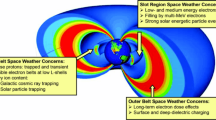Abstract
The paper presents the results of a study of microwave thermal bremsstrahlung of local sources above sunspots. Special attention is paid to the transition from thermal bremsstrahlung to the dominant gyroresonance radiation in the high-frequency part of the spectrum of 12–20 GHz (1.5–2.5 cm). At high frequencies, for which the magnitude of the magnetic field is not enough to generate gyroresonance radiation, thermal bremsstrahlung is the main factor. The presented calculations demonstrate an increase in brightness in an extraordinary mode and a decrease in its intensity in an ordinary mode, as well as corresponding examples of observations. The possibilities and advantages of determination of the field with one polarization corresponding to ordinary radiation are revealed. The studied spectral-polarization features of the radiation, estimates of the effective radiation height, and the characteristic features of the change in the sizes of sources with the wave frequency will make it possible to correctly interpret the observations and to improve the accuracy of magnetic field measurement and the diagnostics of the transition region temperature.








Similar content being viewed by others
REFERENCES
Bogod, V.M., RATAN-600 radio telescope in the 24th solar-activity cycle. I. New opportunities and tasks, Astrophys. Bull., 2011, vol. 66, no. 2, pp. 190–204.
Bogod, V.M. and Gelfreikh, G.B., Measurements of the magnetic field and the gradient of temperature in the solar atmosphere above a flocculus using radio observations, Sol. Phys., 1980, vol. 67, pp. 29–46.
Bogod, V.M., Peterova, N.G., Ryabov, B.I., and Topchilo, N.A., On the recording of an emission with a reduced brightness in the region of a strong sunspot magnetic field, Cosmic Res., 2015, vol. 53, no. 1, pp. 10–20.
Kaltman, T.I. and Bogod, V.M., On detecting the fourth gyrofrequency harmonic in microwave emission spectra above sunspots, Cosmic Res., 2019, vol. 57, no. 1, pp. 1–9.
Kaltman, T.I., Bogod, V.M., Stupishin, A.G., and Yasnov, L.V., The altitude structure of the coronal magnetic field of AR 10933, Astron. Rep., 2012, vol. 56, no. 10, pp. 790–799.
Ryabov, B.I., Gary, D.E., Peterova, N.G., et al., Reduced coronal emission above large isolated sunspots, Sol. Phys., 2015, vol. 290, no. 1, pp. 21–35.
Selhorst, C.L., Silva-Valio, A., and Costa, J.E.R., Solar atmospheric model over a highly polarized 17 GHz active region, Astron. Astrophys., 2008, vol. 488, no. 3, pp. 1079–1084.
Tokhchukova, S.Kh., RATAN-600 radio telescope in the 24th solar activity cycle. IV. Information system for RATAN-600 solar observations, Astrophys. Bull., 2011, vol. 66, no. 3, pp. 379–388.
Tokhchukova, S.Kh., Korzhavin, A.N., and Bogod, V.M., et al., Computation of the horizontal size of the RATAN-600 beam pattern for the “Southern Sector with a Flat Reflector” mode with allowance for the parameters of primary feeds, Astrophys. Bull., 2014, vol. 69, no. 3, pp. 356–367.
Topchilo, N.A., Peterova, N.G., and Borisevich, T.P., The microwave radiation of the corona above a large single sunspot in right- and left-circular polarization, Astron. Rep., 2010, vol. 54, no. 1, pp. 69–85.
Zhang, Ch., Gelfreikh, G.B., and Wang, J., Magnetic field strengths and structures from radio observations of solar active regions, Chin. J. Astron. Astrophys., 2002, vol. 2, pp. 266–276.
Zheleznyakov, V.V., Izluchenie v astrofizicheskoi plazme (Radiation in Astrophysical Plasma), Moscow: Yanus-K, 1997.
Zlotnik, E.Ya., Theory of the slowly changing component of solar radio emission. I. Sov. Astron., 1968, vol. 12, no. 2, pp. 245–253.
Funding
The work was performed as part of the state assignment of the Special Astrophysical Observatory of the Russian Academy of Sciences, no. AAAA-A17-117011810013-4, “Conducting Basic Scientific Research,” with partial support from the Russian Foundation for Basic Research, project no. 18-02-00045.
Author information
Authors and Affiliations
Corresponding author
Rights and permissions
About this article
Cite this article
Kaltman, T.I. Thermal Bremsstrahlung of Local Sources Over Solar Spots Based on Microwave Observations. Geomagn. Aeron. 59, 1088–1095 (2019). https://doi.org/10.1134/S0016793219080097
Received:
Revised:
Accepted:
Published:
Issue Date:
DOI: https://doi.org/10.1134/S0016793219080097




